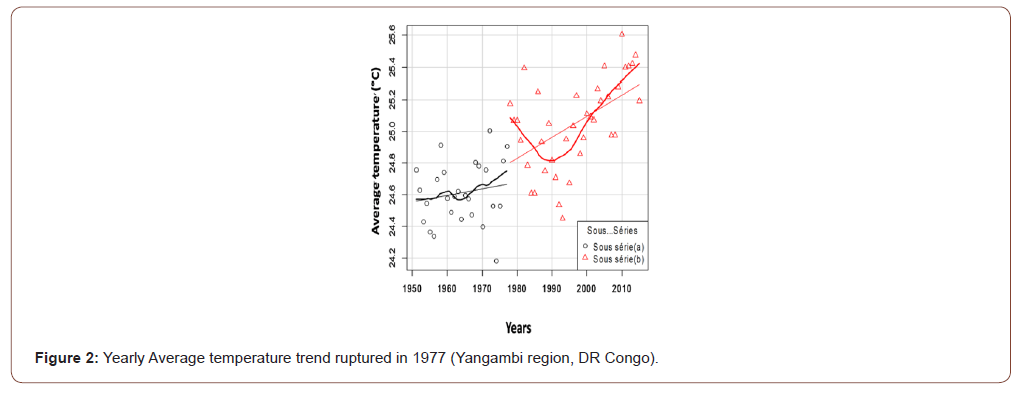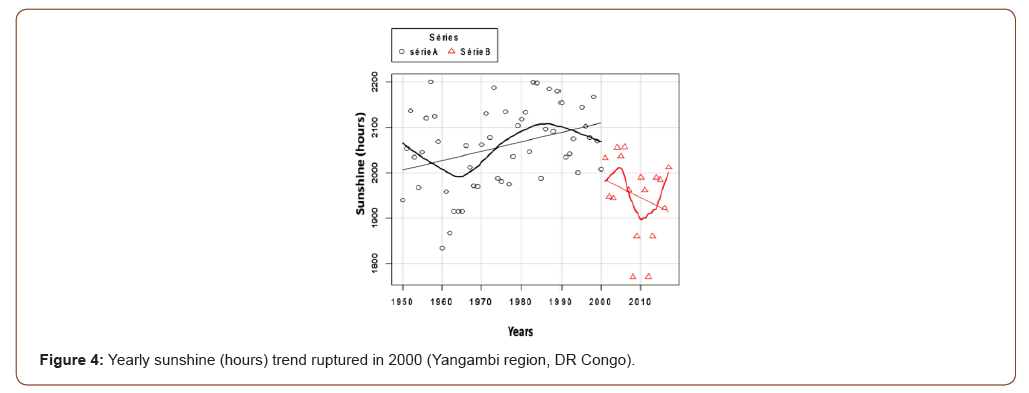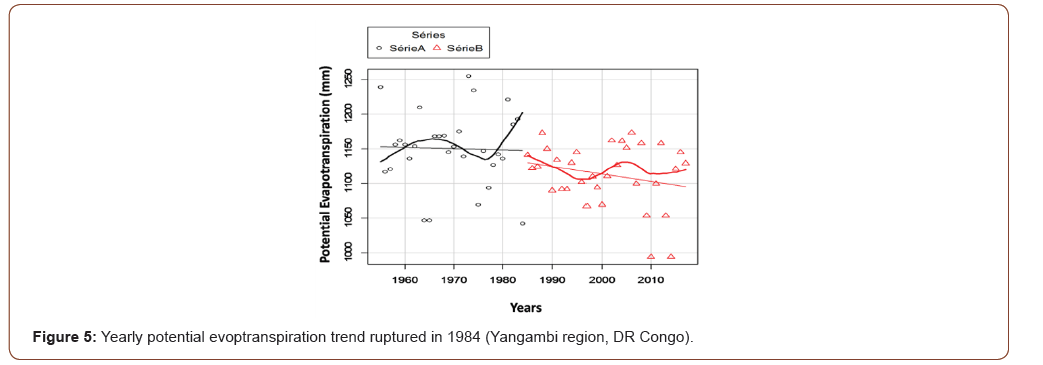 Research Protocol
Research Protocol
Recent Climate Trend of Yangambi Region, DR Congo
Alexandre Likoko B1*, Michel Lokonda O1, Sylvain Alongo L 2, Faustin Boyemba B3 and Ferdinand Kombele B2
1Yangambi INERA, P. B. 2037 Kinshasa Gombe, RD Congo
2IFA-Yangambi. B.P. 1232 Kisangani, RD Congo
3University of Kisangani,B.P.1742, DR Congo
Likoko BA, Yangambi INERA, Natural Resources National Research Program, P.B 2037 Kinshasa Gombe, Congo.
Received Date: March 10, 2020; Published Date: June 18, 2020
Introduction
Global average temperature increase of 0.6°C has changed world environment. In Yangambi, temperature being increased to 0.44°C has yielded disturbed cultural calendar related to decreased crop production, and destroyed vegetations and soils. To lighten peasant farmer, land user and scientist, climatic change on annual and monthly regimes has been studied [1].
Study Field Location
Yangambi forest region (figure 1) is located at 0°49’N, 24° 29’E and 470 meters of altitude on sandy-clay to clayey-sand oxisoil textural and structural catena, vegetated by the pristine evergreen ombrophilous dense forest of Brachystezia laurentii, and semi deciduous forest of Scorodophloeus zenkeri, Pericopsis elata and Gilbertiodendron dewevrei in the central African depression of the DR Congo. Yangambi accounts for 76000 inhabitants. The warm and humid climate of Yangambi is characterized by double periodicity monthly rainfall regime with the annual means of 1822.19±214,8 mm with 172.24±21.90 rainy days, 1132.16±54.43 mm of PET, 87.17±6.97 % of relative air humidity, 2020±98.17 hours of sunshine and the average temperature of 24.98 °C [2].

Methods
Means values of rainfall (mm), number of rainy days (RDN),
relative air humidity (RH, %), potential evapotranspiration (PET,
mm), sunshine (hours) and average temperatures (°C) registered
from 1931-2018 at the Km 5 climatology experimental station
of INERA Yangambi, were computed with Excel and R 3.4 logiciel
to find the independence and non stationary by the test of Wald
Wolfowitz, the trends variations by the test of Mann Kendall,
the significance of the climatic change rupture point at time K
detected by the test of Pettit. Following Croxston and Cowden
model, serial monthly rainfall original data are considered as
the expression of the produced relation T X S X C X I = 0, where
T= secular trend, S=seasonal variations, C=cyclical movement
and I=irregular fluctuations, from which equation the monthly
seasonal rainfall indexes (RSI) were calculated by regression to
find significant monthly polynomial trends change from 1931
to 2018 [1,2]. Agricultural periods were determined following
frequential graphic method of probable rainfall intersected with
PET and PET/2 having established intersections called climatic
events projected on abscissa which have constituted agronomic
scale. Rainfall frequencies were calculated following Markov chains
method in terms of probabilities in percentage of two consecutive
humid decades obtained from the normal of rainfall from 1950 to
2010 (means of two normal’s 1950 to 1980 and 1981 to 2010).
Humidity being defined by the rainfall metry as superior to 30 mm.
The following periods were defined (R=rainfall, PET=potential
evapotranspiration, RET= real evapotranspiration) : -Pre-humid
period (dry), PET/2 The results of the rupture change points of climatic elements
have been shown on the following figures 2-7. The average temperature trend change detected in 1977 was
highly significant (p<0,001) of 0.44°C increase (figure 2) which
has been significantly (r= -0.333) related to highly significant
change RH decrease of -1.35% since 1975 (figure 3). The annual
influence of temperatures on rains, RDN and PET have not been
significant. But their decreasing trend change were detected with
significant decrease of -107.16 mm sunshine since 2000 (figure 4),
decrease of -37.31 mm PET since 1984 (figure 5) and increase of
30.50 RDN since 1950 (figure 6). From figure 7, the unsignificant
(p-value=1,052) annual rainfall lost of -1.753 mm has characterized
since year 2000 inter-seasonal monthly trend disturbances. Four
classical monthly rainfall seasons have been reduced to two new
seasons. The first eco-climatic season (1©) represents the long
rainy season composed of five months: June, August, September,
October and November, has formed the sustainable optimal
vegetative phase within the active vegetative period from mars to
November. Since 2003, the principal maximum of September with
RSI 155% has replaced October (Figure 7). The second season (2©) represents the short rainy season
with three months: March, April and May. June has suffered of a
directional change exponentially inflexed at RSI 110% (121 mm
rainfall) in doubling the amplitude of the season from RSI 7 to 14
%, having left the short dry season. The third season (3©), the
short dry season is constituted by the exponential downing month
of July with RSI 65% in year 2000, which becomes the only month
indecisively dry of the season representing the secondary ecoclimatic
depression with more than 100 mm (145 mm) rainfall.
From 2012, the seasons (1©), (2©) and (3©) are fashioned into
one humid period, March to November. The fourth season (4©)
represents the long dry season with December, January and
February in Yangambi. From 2003, December with 143 mm, has
the highest exponential decreased trend RSI from 60 to 35%,
and has represented the probable driest month replacing rainfall
depressions of January and February. Begin sowing in the third decade of March for less water
demanding crops and the second decade of August for all vegetative
crop cycles. The unique annual humid season, March to November,
has represented agricultural periods as followed : -soil cultivation
period: 5-25 January ; -Pre-humid periods : 25january - 15march
and 18june - 28june ; -Humid periods : 15march - 28may and
28june - 7december ; -Very Humid period (optimal active vegetative
period) : second decade of August – third decade of November ;
-Post-humid periods : 28may - 13june and 7december - 5january
; -Usable water reserve utilization period: 7december - 25january
and 13june -18june. The stationary annual rainfall with highly significant
temperature increase has impacted on monthly rainfall seasonal
indexes yielding trend disturbances since year 2000. In Yangambi,
the climatic changes (but not climate change) occurred with
temperature increase in 1977, relative air humidity decrease
in 1975, rainy days increase in 1950, PET decrease in 1984 and
sunshine decrease in 2000, are still persistently included in the
bimodal regime of warm and humid tropical climate classification
of Köppen, favorable to agriculture and livestock. Probable sowing
commencements are dated on from the third decade of march for
less water demanding crops of less than 90 days vegetative cycle
and the second decade of august for all crops and forest trees [1,2].
One recommends to elucidate more about extending results to
users, evaluating the climatic water balance for soil series of the
catena of Yangambi, studying the agro economic impact of climatic
disturbances on soil fertility of Yangambi, estimating the Yangambi
biosphere reserve aboveground and undergroud carbon stock and
studying hydrographic richness impacts on global hit. We acknowledge climatology researchers for daily data
registration and INERA Yangambi Center and professors listed
ahead for article suprvision. No conflict of interest.Results






Cultural calendar could be reviewed
Conclusion
Acknowledgement
Conflict of Interest
References
- Likoko BA, Likoko AG, Likoko AB, Likoko KJ, Alongo LS, et al. (2019) Agricultural Monthly Rainfall Trends Disturbances in Yangambi Region, DR Congo. J Aqua Sci Oceanography 1: 108.
- Likoko BA, Mbifo N, Besango L, Totiwe B, Badjoko DH, et al. (2019) Climate Change for Yangambi Forest Region, DR Congo. J Aqua Sci Oceanography 1: 201.
-
Alexandre Likoko B, Sylvain Alongo L, Michel Lokonda O, etc all... Recent Climate Trend of Yangambi Region, DR Congo. Ad Oceanogr & Marine Biol. 2(1): 2020. AOMB.MS.ID.000530.
-
Global average temperature, Yangambi, Land, Destroyed vegetations, Soils, Air humidity, Rainy days, Potential evapotranspiration, Seasonal variations, Irregular fluctuations, Cyclical movement
-

This work is licensed under a Creative Commons Attribution-NonCommercial 4.0 International License.






